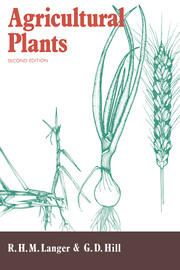Book contents
- Frontmatter
- Contents
- Preface to the first edition
- Preface to the second edition
- 1 World population and crop production
- 2 Plant structure
- 3 Liliaceae
- 4 Poaceae
- 5 Apiaceae
- 6 Asteraceae
- 7 Brassicaceae
- 8 Cannabinaceae
- 9 Chenopodiaceae
- 10 Cucurbitaceae
- 11 Fabaceae
- 12 Lamiaceae
- 13 Linaceae
- 14 Malvaceae
- 15 Papaveraceae
- 16 Solanaceae
- 17 Physiological basis of yield
- Index of specific names
- Subject index
15 - Papaveraceae
Published online by Cambridge University Press: 05 June 2012
- Frontmatter
- Contents
- Preface to the first edition
- Preface to the second edition
- 1 World population and crop production
- 2 Plant structure
- 3 Liliaceae
- 4 Poaceae
- 5 Apiaceae
- 6 Asteraceae
- 7 Brassicaceae
- 8 Cannabinaceae
- 9 Chenopodiaceae
- 10 Cucurbitaceae
- 11 Fabaceae
- 12 Lamiaceae
- 13 Linaceae
- 14 Malvaceae
- 15 Papaveraceae
- 16 Solanaceae
- 17 Physiological basis of yield
- Index of specific names
- Subject index
Summary
Although in Europe this family is best known for its red weed species, it contains one crop of economic importance and social significance, the poppy. This plant is grown for its seeds which yield a valuable, edible oil, but its reputation rests more notoriously on opium derived from its alkaloids which include morphine, codeine and papaverine.
POPPY (PAPAVER SOMNIFERUM)
The poppy is thought to have originated under domestication from a wild progenitor in Asia Minor. The powerful properties of opium must have been recognised at a very early stage. The plant has consequently been cultivated for thousands of years and the drug morphine used in medicine and as a narcotic. It was certainly well known to the Persians, Egyptians, Greeks and Romans. Arab traders took crude opium and seed westward to Europe and eastwards into Asia. Further spread was continued by the Spanish and Portuguese, and this together with the notorious opium trade conducted in the Dutch and British colonial empires has ensured that the plant and its effects are universally known throughout the world. As a crop the poppy is now represented by different cultivars, some cultivated for oil, others for opium. The main producing countries are Turkey, USSR, and some Balkan states. Cultivation for opium is usually under strict government control.
- Type
- Chapter
- Information
- Agricultural Plants , pp. 304 - 307Publisher: Cambridge University PressPrint publication year: 1991

